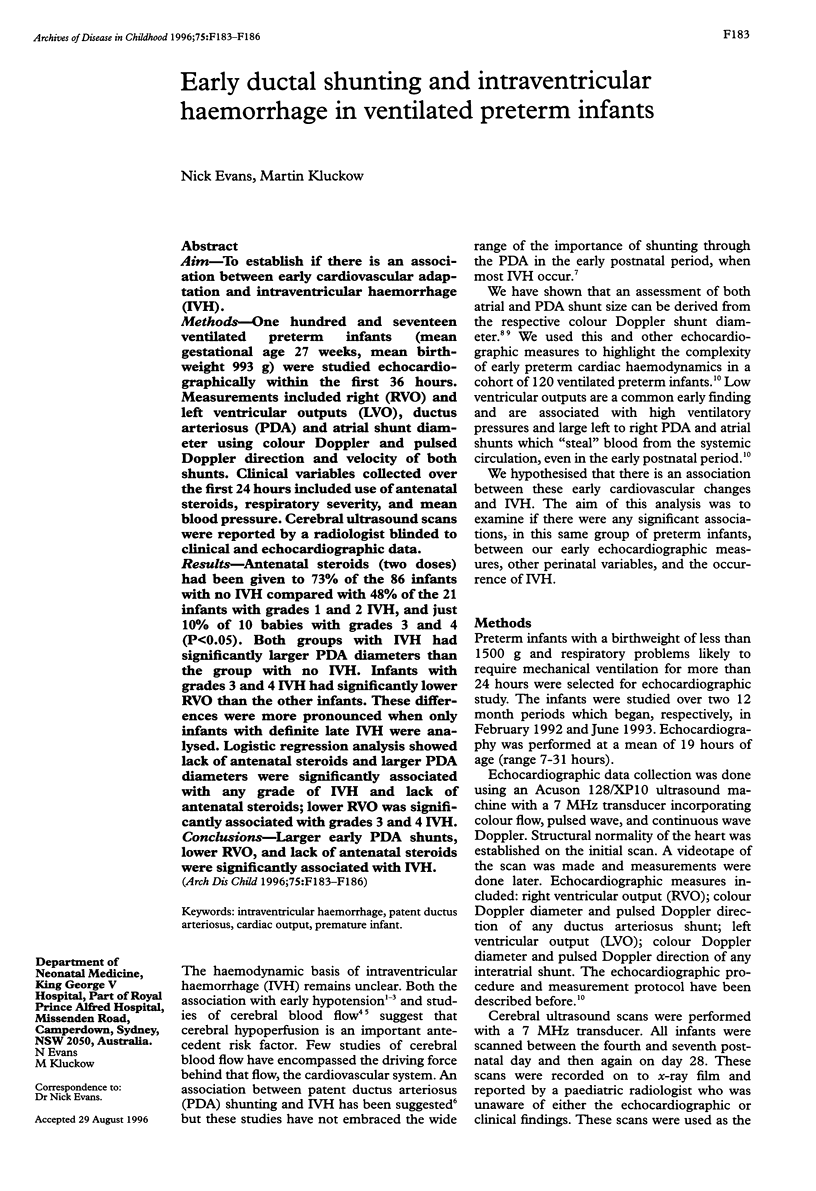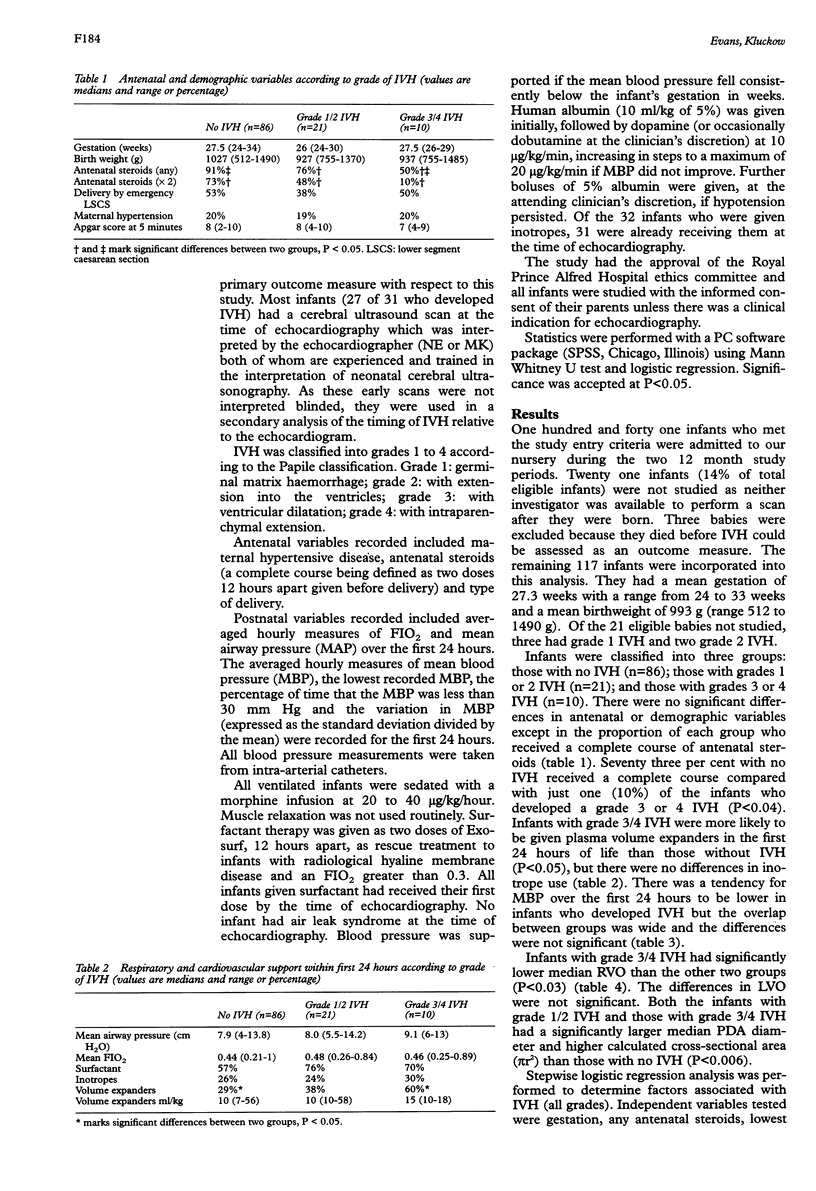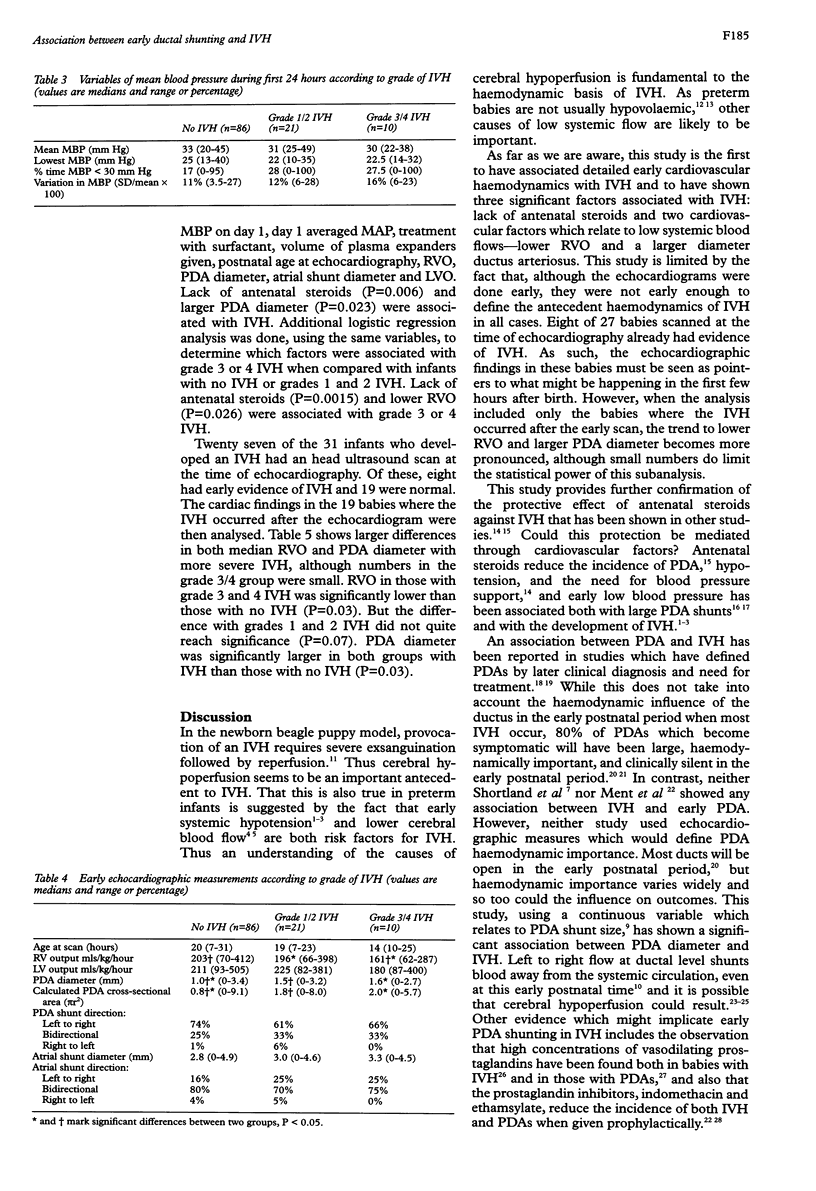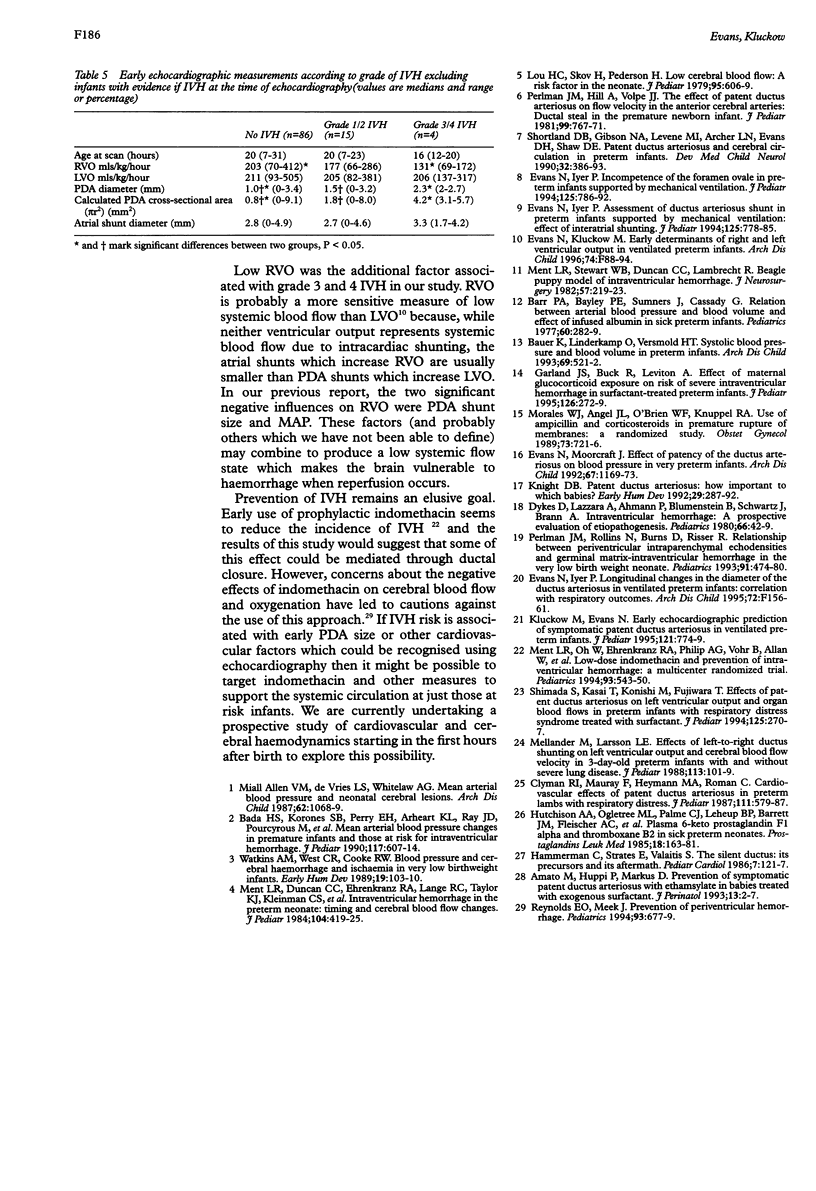Abstract
AIM: To establish if there is an association between early cardiovascular adaptation and intraventricular haemorrhage (IVH). METHODS: One hundred and seventeen ventilated preterm infants (mean gestational age 27 weeks, mean birthweight 993 g) were studied echocardiographically within the first 36 hours. Measurements included right (RVO) and left ventricular outputs (LVO), ductus arteriosus (PDA) and atrial shunt diameter using colour Doppler and pulsed Doppler direction and velocity of both shunts. Clinical variables collected over the first 24 hours included use of antenatal steroids, respiratory severity, and mean blood pressure. Cerebral ultrasound scans were reported by a radiologist blinded to clinical and echocardiographic data. RESULTS: Antenatal steroids (two doses) had been given to 73% of the 86 infants with no IVH compared with 48% of the 21 infants with grades 1 and 2 IVH, and just 10% of 10 babies with grades 3 and 4 (P < 0.05). Both groups with IVH had significantly larger PDA diameters than the group with no IVH. Infants with grades 3 and 4 IVH had significantly lower RVO than the other infants. These differences were more pronounced when only infants with definite late IVH were analysed. Logistic regression analysis showed lack of antenatal steroids and larger PDA diameters were significantly associated with any grade of IVH and lack of antenatal steroids; lower RVO was significantly associated with grades 3 and 4 IVH. CONCLUSIONS: Larger early PDA shunts, lower RVO, and lack of antenatal steroids were significantly associated with IVH.
Full text
PDF



Selected References
These references are in PubMed. This may not be the complete list of references from this article.
- Amato M., Hüppi P., Markus D. Prevention of symptomatic patent ductus arteriosus with ethamsylate in babies treated with exogenous surfactant. J Perinatol. 1993 Jan-Feb;13(1):2–7. [PubMed] [Google Scholar]
- Bada H. S., Korones S. B., Perry E. H., Arheart K. L., Ray J. D., Pourcyrous M., Magill H. L., Runyan W., 3rd, Somes G. W., Clark F. C. Mean arterial blood pressure changes in premature infants and those at risk for intraventricular hemorrhage. J Pediatr. 1990 Oct;117(4):607–614. doi: 10.1016/s0022-3476(05)80700-0. [DOI] [PubMed] [Google Scholar]
- Barr P. A., Bailey P. E., Sumners J., Cassady G. Relation between arterial blood pressure and blood volume and effect of infused albumin in sick preterm infants. Pediatrics. 1977 Sep;60(3):282–289. [PubMed] [Google Scholar]
- Bauer K., Linderkamp O., Versmold H. T. Systolic blood pressure and blood volume in preterm infants. Arch Dis Child. 1993 Nov;69(5 Spec No):521–522. doi: 10.1136/adc.69.5_spec_no.521. [DOI] [PMC free article] [PubMed] [Google Scholar]
- Clyman R. I., Mauray F., Heymann M. A., Roman C. Cardiovascular effects of patent ductus arteriosus in preterm lambs with respiratory distress. J Pediatr. 1987 Oct;111(4):579–587. doi: 10.1016/s0022-3476(87)80126-9. [DOI] [PubMed] [Google Scholar]
- Dykes F. D., Lazzara A., Ahmann P., Blumenstein B., Schwartz J., Brann A. W. Intraventricular hemorrhage: a prospective evaluation of etiopathogenesis. Pediatrics. 1980 Jul;66(1):42–49. [PubMed] [Google Scholar]
- Evans N., Iyer P. Assessment of ductus arteriosus shunt in preterm infants supported by mechanical ventilation: effect of interatrial shunting. J Pediatr. 1994 Nov;125(5 Pt 1):778–785. doi: 10.1016/s0022-3476(94)70078-8. [DOI] [PubMed] [Google Scholar]
- Evans N., Iyer P. Incompetence of the foramen ovale in preterm infants supported by mechanical ventilation. J Pediatr. 1994 Nov;125(5 Pt 1):786–792. doi: 10.1016/s0022-3476(94)70079-6. [DOI] [PubMed] [Google Scholar]
- Evans N., Iyer P. Longitudinal changes in the diameter of the ductus arteriosus in ventilated preterm infants: correlation with respiratory outcomes. Arch Dis Child Fetal Neonatal Ed. 1995 May;72(3):F156–F161. doi: 10.1136/fn.72.3.f156. [DOI] [PMC free article] [PubMed] [Google Scholar]
- Evans N., Kluckow M. Early determinants of right and left ventricular output in ventilated preterm infants. Arch Dis Child Fetal Neonatal Ed. 1996 Mar;74(2):F88–F94. doi: 10.1136/fn.74.2.f88. [DOI] [PMC free article] [PubMed] [Google Scholar]
- Evans N., Moorcraft J. Effect of patency of the ductus arteriosus on blood pressure in very preterm infants. Arch Dis Child. 1992 Oct;67(10 Spec No):1169–1173. doi: 10.1136/adc.67.10_spec_no.1169. [DOI] [PMC free article] [PubMed] [Google Scholar]
- Garland J. S., Buck R., Leviton A. Effect of maternal glucocorticoid exposure on risk of severe intraventricular hemorrhage in surfactant-treated preterm infants. J Pediatr. 1995 Feb;126(2):272–279. doi: 10.1016/s0022-3476(95)70560-0. [DOI] [PubMed] [Google Scholar]
- Hammerman C., Strates E., Valaitis S. The silent ductus: its precursors and its aftermath. Pediatr Cardiol. 1986;7(3):121–127. doi: 10.1007/BF02424985. [DOI] [PubMed] [Google Scholar]
- Hutchison A. A., Ogletree M. L., Palme C. J., Leheup B. P., Barrett J. M., Fleischer A. C., Stahlman M. T., Brigham K. L. Plasma 6-keto prostaglandin F1 alpha and thromboxane B2 in sick preterm neonates. Prostaglandins Leukot Med. 1985 May;18(2):163–181. doi: 10.1016/0262-1746(85)90017-4. [DOI] [PubMed] [Google Scholar]
- Kluckow M., Evans N. Early echocardiographic prediction of symptomatic patent ductus arteriosus in preterm infants undergoing mechanical ventilation. J Pediatr. 1995 Nov;127(5):774–779. doi: 10.1016/s0022-3476(95)70172-9. [DOI] [PubMed] [Google Scholar]
- Knight D. B. Patent ductus arteriosus: how important to which babies? Early Hum Dev. 1992 Jun-Jul;29(1-3):287–292. doi: 10.1016/0378-3782(92)90179-k. [DOI] [PubMed] [Google Scholar]
- Lou H. C., Skov H., Pedersen H. Low cerebral blood flow: a risk factor in the neonate. J Pediatr. 1979 Oct;95(4):606–609. doi: 10.1016/s0022-3476(79)80779-9. [DOI] [PubMed] [Google Scholar]
- Mellander M., Larsson L. E. Effects of left-to-right ductus shunting on left ventricular output and cerebral blood flow velocity in 3-day-old preterm infants with and without severe lung disease. J Pediatr. 1988 Jul;113(1 Pt 1):101–109. doi: 10.1016/s0022-3476(88)80542-0. [DOI] [PubMed] [Google Scholar]
- Ment L. R., Duncan C. C., Ehrenkranz R. A., Lange R. C., Taylor K. J., Kleinman C. S., Scott D. T., Sivo J., Gettner P. Intraventricular hemorrhage in the preterm neonate: timing and cerebral blood flow changes. J Pediatr. 1984 Mar;104(3):419–425. doi: 10.1016/s0022-3476(84)81109-9. [DOI] [PubMed] [Google Scholar]
- Ment L. R., Oh W., Ehrenkranz R. A., Philip A. G., Vohr B., Allan W., Duncan C. C., Scott D. T., Taylor K. J., Katz K. H. Low-dose indomethacin and prevention of intraventricular hemorrhage: a multicenter randomized trial. Pediatrics. 1994 Apr;93(4):543–550. [PubMed] [Google Scholar]
- Ment L. R., Stewart W. B., Duncan C. C., Lambrecht R. Beagle puppy model of intraventricular hemorrhage. J Neurosurg. 1982 Aug;57(2):219–223. doi: 10.3171/jns.1982.57.2.0219. [DOI] [PubMed] [Google Scholar]
- Miall-Allen V. M., de Vries L. S., Whitelaw A. G. Mean arterial blood pressure and neonatal cerebral lesions. Arch Dis Child. 1987 Oct;62(10):1068–1069. doi: 10.1136/adc.62.10.1068. [DOI] [PMC free article] [PubMed] [Google Scholar]
- Morales W. J., Angel J. L., O'Brien W. F., Knuppel R. A. Use of ampicillin and corticosteroids in premature rupture of membranes: a randomized study. Obstet Gynecol. 1989 May;73(5 Pt 1):721–726. [PubMed] [Google Scholar]
- Perlman J. M., Hill A., Volpe J. J. The effect of patent ductus arteriosus on flow velocity in the anterior cerebral arteries: ductal steal in the premature newborn infant. J Pediatr. 1981 Nov;99(5):767–771. doi: 10.1016/s0022-3476(81)80408-8. [DOI] [PubMed] [Google Scholar]
- Perlman J. M., Rollins N., Burns D., Risser R. Relationship between periventricular intraparenchymal echodensities and germinal matrix-intraventricular hemorrhage in the very low birth weight neonate. Pediatrics. 1993 Feb;91(2):474–480. [PubMed] [Google Scholar]
- Reynolds E. O., Meek J. Prevention of periventricular hemorrhage. Pediatrics. 1994 Apr;93(4):677–679. [PubMed] [Google Scholar]
- Shimada S., Kasai T., Konishi M., Fujiwara T. Effects of patent ductus arteriosus on left ventricular output and organ blood flows in preterm infants with respiratory distress syndrome treated with surfactant. J Pediatr. 1994 Aug;125(2):270–277. doi: 10.1016/s0022-3476(94)70210-1. [DOI] [PubMed] [Google Scholar]
- Shortland D. B., Gibson N. A., Levene M. I., Archer L. N., Evans D. H., Shaw D. E. Patent ductus arteriosus and cerebral circulation in preterm infants. Dev Med Child Neurol. 1990 May;32(5):386–393. doi: 10.1111/j.1469-8749.1990.tb16957.x. [DOI] [PubMed] [Google Scholar]
- Watkins A. M., West C. R., Cooke R. W. Blood pressure and cerebral haemorrhage and ischaemia in very low birthweight infants. Early Hum Dev. 1989 May;19(2):103–110. doi: 10.1016/0378-3782(89)90120-5. [DOI] [PubMed] [Google Scholar]


